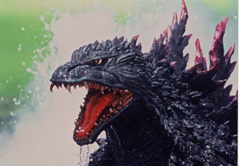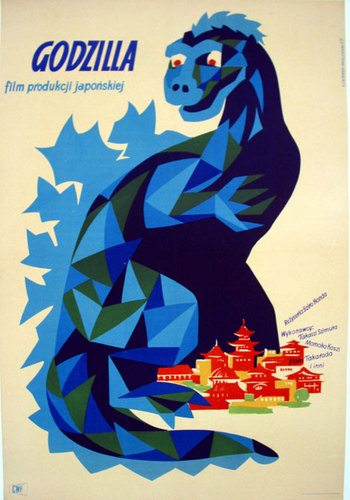Godzilla, Monster King
Godzilla is my favorite monster
Here he goes to kick some ass...{click on Godzilla to check out his biology by Darren Naish, phD}
Godzilla is a liscensed critter of Toho films[tm] all rights reserved. Check out their latest effort w/ Atari
3
Get yourself a model or ten of Godzilla through the years by clicking on the model at right.[1962 shown]
This Godzilla was done by Norman Graf
Pretty cool, huh?
Click at Right for Cool Godzilla Page

Image title would go here.

Breadwig Godzilla.
3

I have days like this...
Newest Godzilla

Mechagodzilla

College classes... he's the bomb, click poster.
Real Godzilla

'Godzilla' monster lurked in ancient seas
19:00 10 November 2005 NewScientist.com news service Jeff Hecht
The sea monster nicknamed Godzilla warns pterosaurs that this meal already is taken (Artist's impression: DAMNFX/National Geographic)Tools Related Articles Long-necked sea monsters had shellfish desires 06 October 2005 Dinosaur special: Extreme palaeontology 21 May 2005 Meat-eating dinosaur caught turning veggie 04 May 2005 Search New Scientist Contact us Web Links Science National Geographic Enlarge image The fossil crocodyliform skull (front) acquires “flesh” as a digitised model (rear) (Photo of skull: Robert Clark, Museo de La Plata; Computer model: DAMNFX/National Geographic)A new, virtually complete fossil skull has revealed that an ancient marine relative of the crocodile was a very strange sea monster indeed. The 80-centimetre-long fossil, discovered in Argentina, shows that Dakosaurus andiniensis had the massive and terrifying skull of a predatory dinosaur. Previously known only from bone fragments, the animal was nearly 4 metres (12 feet) long, with four flippers and the tail of a fish. The leader of the National Geographic-funded expedition that discovered the skull, Zulma Gasparini of the National University of La Plata in Argentina, dubbed the creature "Godzilla". Dakosaurus prowled the Pacific Ocean some 135 million years ago along with ichthyosaurs, plesiosaurs, and other now-extinct marine reptiles. But Dakosaurus was not a true dinosaur or a true crocodile: it was a crocodyliform. Stunningly different The crocodyliforms evolved about the same time as dinosaurs, and initially lived on land. But during the Jurassic period some evolved to resemble modern crocodiles and moved into the oceans, where their limbs evolved into paddles. Most had flat heads and long, thin tubular snouts with many small thin teeth, suitable for snaring fish and other small, fast-moving prey. But the new find is stunningly different from Dakosaurus fossils found previously in Europe, and other marine crocodyliforms. Instead of a flat head and long thin snout, D. andiniensis had a head about 30 centimetres high, a short, stout snout, a powerful jaw and serrated cutting teeth like those of predatory dinosaurs. It probably ate large marine reptiles like ichthyosaurs and plesiosaurs, says Diego Pol of Ohio State University. "It's a cool fossil," says crocodile specialist Chris Brochu at the University of Iowa, US. He adds that it also contradicts one of the laws formulated by 19th-century palaeontologist Edward Drinker Cope. Cope postulated that specialist species evolve from generalists, and not the other way around. Yet Brochu says "this guy's ancestors were specialists with tube snouts", but its skull looks like that of a generalist. Journal reference: Science (DOI: 10.1126/science.1120803)
dude








